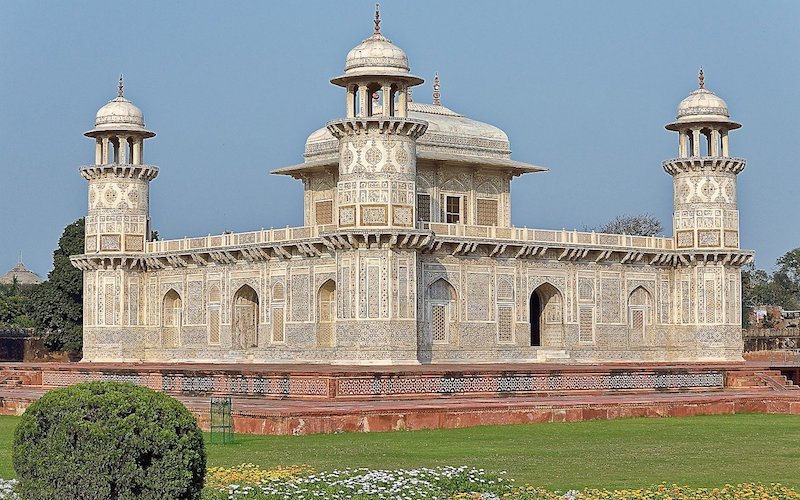Agra is most famous for the Taj Mahal, the world famous Indian monument of love. Yet there are so many more places to visit in Agra beyond the Taj Mahal. Although many Golden Triangle tours do a whistle stop Taj Mahal tour and move on, I would encourage you to spend at least 3 days in Agra exploring the amazing sites beyond the Taj.
Places to Visit in Agra – The Taj Mahal
What is broadly considered as the most stunning building in the world, Taj Mahal is situated in the historical city of Agra. It was made by the Mughal Emperor Shah Jahan as a monument for his third wife, Mumtaz Mahal. Constructed entirely out of white marble in the 17th century, it is among the finest edifices of Mughal architecture.
Recognisable by the UNESCO as a world heritage site, this amazing monument is considered to be one of the seven wonders of the modern world.
Each year visitors more than the entire population of Agra pass through the superb gates to catch a sight of this breath-taking shrine, and very few leave disappointed. Taj Mahal characterises the premium artistic and architectural achievement through faultless craftsmanship in a range of Indo-Islamic sepulchral architecture. It is a masterwork of style in treatment, execution and conception and has so many unique aesthetic qualities in harmonious blending of various elements and symmetry.

Places to Visit in Agra – Beyond the Taj Mahal
Agra Fort
A masterpiece of architecture, Agra Fort was built by Emperor Akbar in 1573. It’s actually a massive fortification located on the right bank of the River Yamuna in Agra, Uttar Pradesh. Agra Fort is made out of red sandstone.
The fort was once the residence of the Mughals until the year 1638. One of the UNESCO World Heritage Sites and sits at a distance of 2.5km from another wonder of the world, the well-known Taj Mahal. The part of Agra Fort is so large that it is sometimes referred to as a walled city.
Crafted from red sandstone brought to Agra from Rajasthan, this impressive structure is as regal as it is attractive and delicate. The fort is one of the best places to Visit in Agra after the Taj Mahal.

Itmad-ud-Daula
Regularly referred to as the “Baby Taj Mahal”, this tomb of Itimad-ud-daulah is a Mughal mausoleum and sometimes regarded as a duplicate of the Taj Mahal. This is the first tomb in India which is made completely of marble.
It is the tomb of Mir Gheyas Beg (who was later known as Itimad-ud-daulah) and was a minister in the court of Shah Jahan. Visiting this tomb is like taking a step back in time into the history of Agra.
The tomb of Itimad-ud-daulah symboles the transition from the initial phase of the Mughal architecture to the second. This was the first structure to which made use of pietra dura and the first ever to be crafted on the banks of the Yamuna River. It consists of Indo-Islamic architecture, with the use of octagonal shaped towers and arched entrances. If you take a bird’s eye view of Itimad-ud-daulah Tomb, it can be looked at like a jewel box set in a garden.

Tomb of Akbar the Great
This outstanding sandstone and marble tomb commemorate the greatest of the Mughal emperors. The massive courtyard is entered through a stunning gateway ornamented with three-storey minarets at every corner and made of red sandstone extraordinarily inlaid with yellow, white and blue marble floral and geometric patterns.
The interior entrance of the tomb is decorated stunningly with painted alabaster, creating a interesting contrast to the plain inner tomb. The unusual upper pavilions are closed. Look for deer in the surrounding gardens. The mausoleum is found at Sikandra, 10km northwest of Agra Fort.

Chini Ka Rauza
Chini Ka Rauza is tomb and funerary monument made primarily of colourful tiles of chini. It was an aftermath of Mullah Shukrullah Shirazi, who was not only one of the best scholars and a poet but also the prime minister of Mughal Emperor Shah Jahan.
Situated on the bank of river Yamuna one kilometre away from the tomb of Itmad-ud-Daulah, it was built in 1635. It was the first building of its kind in India that was embellished extensively with tiles of glazed glass and is, therefore, aptly regarded as a landmark in Indo-Persian style of architecture in India.
https://www.instagram.com/p/B3MkT_YnW9N/
Jama Mosque Agra
Everything about the Jama Masjid is surreal, from its design to its architecture. Maybe that is why it has been compared to Baitul-Mamur, a pearls and rubies studded mosque believed to be located in jannah (heaven).
Made by Shah Jahan in 1648 AD, it was devoted to his daughter, Jahanara Begum. The perfection in its art and design make it one of the most visited tourist attractions in Agra.
Located just opposite the Agra Fort, the Jama Masjid is one of the largest mosques in India. It is constructed on a large platform which is accessible by a flight of 35 steps. Indeed, its enormous size makes it visible from a distance and attracts the believers from afar. It is a monument which evokes wonder and awe and is of immense cultural and historical importance.
Moti Masjid
Moti Masjid of Agra is a mosque which is situated inside Agra Fort. Be sure not to confuse it with the Moti Masjid that is located inside Red Fort of Delhi.
Moti can be translated as pearl. This mosque is known for its architectural beauty and serene environment. Tourists of every religion can enter into the mosque. The mosque stands on a sloping base and on the courtyard of the mosque there are several arched recessions and side arcades.
There is a total of three domes found on the top crafted with white marble. You will also find Kiosks inside the mosque and it is made very close to the River Yamuna. Most mosques in the world have four steps in the podium but this mosque contains only three steps. You can also find a decorated marble screen inside the prayer hall, which segregates the place where women meet to pray.
https://www.instagram.com/p/Bkl9RFZg-DH/
Tomb of Mariam-uz-Zamani
The Tomb of Mariam-uz-Zamani is the mausoleum of Jodha Bai, the Hindu consort of the Mughal Emperor Akbar, located on the left side of Agra-Mathura road, to the west of Akbar’s tomb in Sikandra.
The tomb was made by Jahangir in memory of Mariam-uz-Zamani (his mother) and was situated near Akbar’s Tomb as the last wish expressed by her. Originally the structure was a baradari under Sikander Lodi who built it in AD 1495. It was later modified into Mughals tomb by reconstructing the 4 facades of the building in Mughal style.
The ground floor consists of around forty chambers built by Sikander Lodi, which bear faint traces of paintings on plastered walls. The centre of the ground floor houses the original cenotaph of Jodha. This square tomb stands right in the centre of the Mughal garden. It is built of brick and mortar and finished with stucco.
https://www.instagram.com/p/B5A0XbUJ8rZ/
What to Pack for Places to Visit in Agra
Consider packing conservative clothing and a shawl or headscarf for women if you would like to visit religious places. Some comfortable sandals work well in India as it can be hot so they will let your feet breathe. It can get extremely hot in some parts of India and so sun cream is essential.

It’s a good idea to pack conservative clothing for India. Avoid short skirts and low cut tops or spaghetti straps. Comfortable trousers and linen tops are great. Long skirts and Maxi dresses also work really well and are comfortable with the heat. Comfortable loose cotton or linen trousers are perfect. Don’t forget your sunglasses, and pack your prescription sunnies if you have those!

If you enjoyed this blog on the best places to visit in Agra, you might also be interested in reading about places to visit in Jaipur. If you have more time to spare in India after the Golden Triangle route, I suggest Pushkar as a relaxing add on to this journey. It a holy city on India’s Holy Lake with one of the few Brahma temples in India. Here are the best places to visit in Pushkar.
